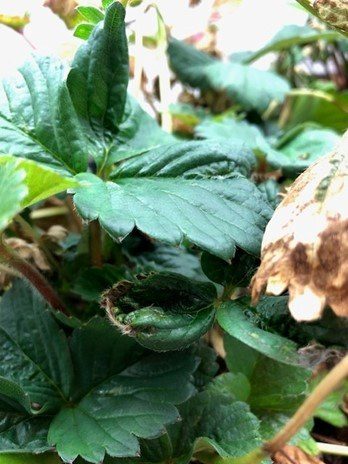News Plant Pest(s): Leaf nematodes threaten our strawberries.
Leaf nematodes? What are they?
When people think of damage caused by nematodes, they think mainly of those that live in the soil and cause damage to the root system of plants. These mini worms cause plants to grow poorly, turn yellow and wilt more quickly under drought conditions. Few people know that there are also nematodes that damage above-ground plant parts, such as leaves, stems, flowers, seeds and fruits.
In Europe, there are 3 economically important species of these leaf nematodes: Aphelenchoides besseyi, Aphelenchoides fragariae and Aphelenchoides ritzemabosi. Aphelenchoides besseyi, the rice leaf nematode, is found only in southern and eastern Europe, in regions where rice is grown. Worldwide, this nematode is responsible for significant production losses in this crop. The chrysanthemum leaf nematode (Aphelenchoides ritzemabosi) and the strawberry leaf nematode (Aphelenchoides fragariae), are two species of leaf nematode that do occur throughout Europe.
In Belgium, only the strawberry leaf nematode poses a threat. This nematode has many host plants, but strawberry (Fragaria x ananassa) is the most important one. The strawberry leaf nematode has the status of RNQP (Regulated Non-Quarantine Pest), which means that the nematode is not allowed to be present in propagating material and certified strawberry propagating material. The other leaf nematodes also have RNQP status in strawberry. Despite these special precautions, problems with leaf nematodes, specifically A. fragariae, were identified in strawberries in 2024 and in 2025 the problem has expanded ever since.
How can you recognize the symptoms?
The typical damage picture in strawberry is deformation of the leaves (Picture 1). The leaves are wrinkled, do not grow properly, are dark colored and the leaf surface is hard and rough. The leaves also show necrotic spots and may eventually die completely. Leaf and flower buds are also affected; they turn brown and fall off, leading to reduced yields.

Only on strawberry?
In addition to strawberry, several other plants are susceptible to attack by A. fragariae, such as anemone, azalea, begonia, calathea, ficus, hydrangea, hosta, peperomia, peony, phlox,... Ferns are very good host plants for this nematode. Many common weeds are also host plants for this nematode: shepherd's purse, lesser creeping weed, black nightshade, celery prize and more.... These nematodes can even feed and reproduce on fungi.
Life cycle of leaf nematodes
Leaf nematodes have a short life cycle: at 18°C they live only 10 to 14 days, which allows them to grow very rapidly in numbers in a short period of time. When the leaf is moist, the nematodes can enter through the stomata or through the thinner epidermis at the base of the leaf (endoparasitic growth). The movement of the nematodes inside the leaf is restricted by the leaf veins which can lead to a typical mosaic-like damage pattern (Picture 2)

Leaf nematodes can also live ectoparasitically (on the outside of the plant) inside the folded crown or in the flower buds.
Leaf nematodes can only survive in soil for a short time (4 weeks), but in dried plant material they can survive in a desiccated state (adults and last larval stage) for several months. When conditions are favorable again, they can reinfect the plants via a water film on them (Picture 3).

What can you do to prevent spreading?
Leaf nematodes can spread quickly between plants, especially when plants touch each other and a film of water is present on the plants. Affected plants should therefore be removed and destroyed as soon as possible. When possible, the plants should not touch each other and the crop should be kept as dry as possible. In addition, classical hygiene measures also apply: all tools and pots should be disinfected by hot water treatment and plant residues are best cleaned up quickly. Nematodes can also be spread through splashing water and, of course, through contaminated propagating material. Finally, hand and clothing hygiene can help prevent spread after contact with (infected) plants.
What does ILVO do?
ILVO's Diagnostic Centre for Plants can extract leaf nematodes from plants and then quantify and morphologically identify them using microscopic and molecular detection techniques. To address the increasing problem with leaf nematodes, two research projects are being prepared.
 Diagnostic Centre for Plants
Diagnostic Centre for Plants